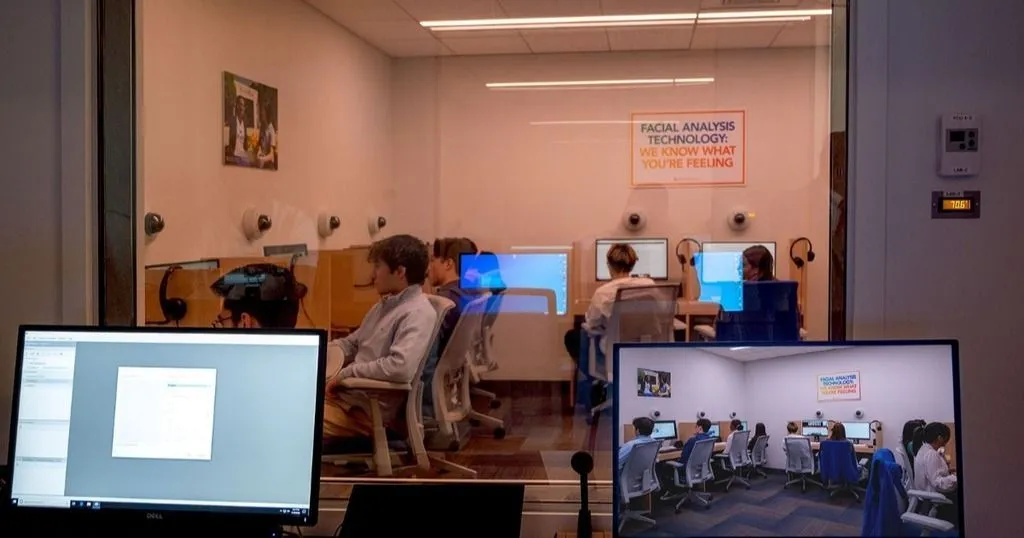Behind the Scenes: Human Behavior Research Labs
Observation and analysis of human behavior is often done in labs. From babies to business, it can all be researched. Want to see how some of this research is done? Check out these amazing human behavior labs in action.
Posted by
Published on
Mon 14 Aug. 2023
Topics
| FaceReader | Labs | The Observer XT | Video Observation | Viso | Multimodal Research |

Exploring human behavior is at the heart of our business. We have made it our mission to help researchers around the world advancing their research. Observation and analysis of human behavior is often done in labs. From babies to business, it can all be researched. Want to see how some of this research is done? Check out these amazing human behavior labs in action.
Behind the Scenes: Human Behavior Research Labs
Over the past three decades we've been building research labs all over the world. They are always fully integrated with hardware and software for observation, recording, and analysis. Do you want to get some insights into some of the world's best human behavior labs? We go behind the scenes of some renowned behavioral research labs.
Behavioral Research in Business Laboratory
Hofstra University in Hempstead, NY is home to a state-of-the-art facility that was specifically designed to conduct multi-disciplinary behavioral research. The Behavioral Research in Business Laboratory is powered by cutting-edge software and tools, that are all geared toward analyzing behavior for business-focused research.
The lab has a total of 27 workstations, divided over several lab and observation rooms. Analytical hardware like eye-tracker devices and software like FaceReader, Viso, and The Observer XT enables them to design, conduct, and analyze complex research studies.
We visited the lab at the Frank G. Zarb School of Business to see it in action. We also spoke to Dr. Anil Mathur, Brodlieb Distinguished Professor in Business and director of the Behavioral Research in Business Lab. Watch the video to discover more about the lab and how Dr. Anil Mathur designed this lab for the future, together with Noldus.
“The advice I would give is, think of the future. Actually that was one of the driving things when we asked Noldus to help us design this lab: I don't want to design the lab with my today's research questions. I want to design the lab that can help me research questions five years down the road. And actually this is exactly what is happening. New problems, new questions will come up that I would like to answer tomorrow."
Buyer’s guide to the perfect audiovisual lab
Free buyer's guide
- What is an audiovisual lab?
- What do you need to complete your setup?
- How does an audiovisual lab help you answer your research questions?
Research in Educational Psychology
Researchers at the Leipzig University focus on gaining further insights into future teachers' moral emotions using Noldus' tools. The research team is focusing on professionalization of teachers and with the upgrade of their lab, they are able to measure facial expressions automatically instead of relying on self-reports. A Tobii eye tracker enables them to include reading research in their studies.
Prof. Dr. Brigitte Latzko and Dr. Sandra Dietrich show us the upgrade of their lab at the Faculty of Education, Leipzig University in Germany. With this new lab, they will start a whole new line of research in educational psychology. Watch the video below to learn more about their research, and why they choose Noldus' tools.
“We need a lab that works; where people very quickly can learn how to work with all the software and the technology.
That is what we got from Noldus.”
Dr. S. Dietrich | Leipzig University, Germany
Human factors research in a ship bridge simulator
MARIN is one of the world's leading maritime research institutes, based in The Netherlands. They have a state-of-the-art ship bridge simulator, where a complete ship's crew can undergo training and observation, exposing them to various demanding scenarios. Following a simulation, debriefing occurs immediately, allowing for the assessment and enhancement of their decision-making and performance in these pivotal 'safety-critical' circumstances.
They are also developing a brand new 'seven oceans simulation center' which is integrated with a Noldus toolkit for human factors research.
Hans Huisman shows us around the ship bridge simulator at MARIN. Take a look behind the scenes of their unique simulator, and how they do multimodal research into human decision making.
Child development research at Baby and Child Research Center
At the Baby & Child Research Center (BRC) in Nijmegen, The Netherlands, researchers are part of a large European Research project that collects data to identify differences in behavior and brain development in young children. Professor Sabine Hunnius and Johanna Harder, research assistant, explain more about the behavioral and developmental tests that are done.
This helps to gain better insight in how, for example, autism or ADHD develops, what the children's social skills are, and what their developmental age is. Because the better we understand typical and atypical development, the better we will be able to develop treatments and interventions for children with developmental conditions, such as autism and ADHD.
Early childhood development research at the Fisher-Price Play Lab
When observing children, and looking at how they play with toys, it's important that they're able to use the toy and have fun with it. But that it also challenges them so that they're able to reach a new milestone and grow to the next level.
At the Fisher-Price Play Lab in East Aurora, New York, the kids are the real experts! Dr. Corinne Eggleston, manager of early childhood development research, and Nicole Mackiewicz, child testing researcher at Fisher-Price, tells us how they have proven in the Play Lab that their line of toys, the Linkimals™, promotes learning.
They used Noldus' Viso to record the interactions the children have with the toys. They used The Observer XT for coding behavior and analyzing the results.
More interesting reads
- How to choose the best audiovisual lab for your project
- How to train students in soft skills: Tools and Techniques
- Resources on Psychology Research: Case Studies, Webinars and White Papers
- UX Research Tools for analyzing and visualizing your user research
- Three UX Lab examples with the latest UX research tools
- Using an AV lab to teach skills for counseling psychology
REQUEST INFORMATION
Interested in our behavioral research solutions? Let's talk!
- Advance your research
- Get expert guidance
- Profit from our 35+ years of experience
Related Posts

Scientific methods in human behavior research

Validating FaceReader's attention detection: a reliable measure using gaze and head pose
